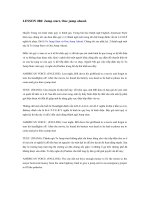biodieselcomposition gerhardknothe 2012 08
Bạn đang xem bản rút gọn của tài liệu. Xem và tải ngay bản đầy đủ của tài liệu tại đây (2.3 MB, 62 trang )
Biodiesel Composition and Fuel
Properties
Gerhard Knothe
USDA / ARS / NCAUR
Peoria, IL 61604
U.S.A.
E-mail:
It All Began With…
… the Diesel Engine
Diesel’s Vision:
Develop an engine more efficient than the
steam engine, but …
Rudolf Diesel did not originally
investigate vegetable oils as fuel.
Rather…
Diesel’s first engine
The Original Demonstration in
the Words of Rudolf Diesel
“At the Paris Exhibition in 1900 there was shown by the Otto
Company a small Diesel engine, which, at the request of the French
Government, ran on Arachide (earth-nut or pea-nut) oil, and worked
so smoothly that only very few people were aware of it. The engine
was constructed for using mineral oil, and was then worked on
vegetable oil without any alterations being made.
R. Diesel, The Diesel Oil-Engine,
Engineering
93:395–406 (1912). Chem. Abstr. 6:1984 (1912).
The Original Demonstration in
the Words of Rudolf Diesel
The French Government at the time thought of testing the applicability to
power production of the Arachide, or earth-nut, which grows in
considerable quantities in their African colonies, and which can be easily
cultivated there, because in this way the colonies could be supplied with
power and industry from their own resources, without being compelled to
buy and import coal or liquid fuel.”
Diesel, R., The Diesel Oil-Engine,
Engineering
93:395–406 (1912). Chem. Abstr. 6:1984 (1912).
Vegetable Oils as Alternative Fuel for
Energy Independence: Not a New
Concept
● 1920’s-1940’s: Many European countries interested in vegetable oils
as fuels for their African colonies in order to provide a local energy
source.
● Also interest in Brazil, China, India.
● A.W. Baker and R.L. Sweigert,
Proc. Oil & Gas Power Meeting of the
ASME
:40-48 (1947): “The United States is one of the countries in
the world fortunate enough to have large supplies of petroleum,
which its inhabitants have not always used wisely. With a possible
diminishing supply of oil accompanied by an increase in consumption,
the study of substitute fuels becomes of some importance. Vegetable
oils loom as a possibility for engines of the compression-ignition type.”
The First Report on Biodiesel
Belgian Patent 422,877 (1937): Procédé de transformation d’huiles
végétales en vue de leur utilisation comme carburants.
An Extensive Report on Biodiesel
“Old” Research:
First Cetane Number
Determination for Biodiesel
Bulletin Agricole du Congo Belge, Vol. 33, p. 3-90 (1942)
:
(Potential) Sources of Biodiesel
• Vegetable oils
• Classical (edible) commodity oils (palm, rapeseed /
canola, soybean, etc.)
• “Alternative” (inedible) oils (jatropha, karanja, pennycress, etc.)
• Animal fats
• Used cooking oils
• “Alternative” feedstocks
• Algae
• Variety of feedstocks with considerably varying fatty acid profiles
• Fuel properties vary considerably
Why biodiesel and not the neat oil?
CH
2
-OOCR
1
R ׳OOCR
1
CH
2
OH
| Catalyst |
CH-OOCR
2
+ 3 R ׳OH → R ׳OOCR
2
+ CHOH
| |
CH
2
-OOCR
3
R ׳OOCR
3
CH
2
OH
Vegetable Oil Alcohol Vegetable Oil Alkyl Esters Glycerol
(Triacylglycerol) (Biodiesel)
Viscosity!
27-35 mm
2
/sec 4-5 mm
2
/sec
Kinematic viscosity of petrodiesel fuels usually ≈ 1.8-3.0 mm
2
/sec.
Major Ester Components of Most
Biodiesel Fuels
Fatty esters in from common vegetable oils (palm, soybean, canola/rapeseed,
sunflower, etc):
• Methyl palmitate (C16:0): CH
3
OOC-(CH
2
)
14
-CH
3
• Methyl stearate (C18:0): CH
3
OOC-(CH
2
)
16
-CH
3
• Methyl oleate (C18:1, ∆9
c
): CH
3
OOC-(CH
2
)
7
-CH=CH-(CH
2
)
7
-CH
3
• Methyl linoleate (C18:2; all
cis
): CH
3
OOC-(CH
2
)
7
-(CH=CH-CH
2
)
2
-(CH
2
)
3
-CH
3
• Methyl linolenate (C18:3; all
cis
): CH
3
OOC-(CH
2
)
7
-(CH=CH-CH
2
-)
3
-CH
3
From other oils:
• Methyl laurate (C12:0): CH
3
OOC-(CH
2
)
10
-CH
3
• Methyl ricinoleate (C18:1, 12-OH;
cis
):
CH
3
OOC-(CH
2
)
7
-CH=CH-CH
2
-CHOH-(CH
2
)
5
-CH
3
• Algal Oils:
Methyl eicosapentaenoate (C20:5): CH
3
OOC-(CH
2
)
3
-(CH=CH-CH
2
-)
5
-CH
3
Methyl docosahexaenoate (C22:6): CH
3
OOC-(CH
2
)
2
-(CH=CH-CH
2
-)
6
-CH
3
Minor Constituents in Biodiesel
• Can influence fuel properties
• Cold flow, oxidative stability, corrosion, combustion, catalyst
poisons, lubricity
CH
2
-OOCR
1
CH
2
OOCR
1
CH
2
OOCR
| | │
CH-OOCR
2
CHOOCR
2
CHOH
| | │
CH
2
-OOCR
3
CH
2
OH CH
2
OH
• Triacylglycerols • Diacylglycerols • Monoacylglycerols
• Glycerol
• Free Fatty Acids: R-COOH
• Alcohol
• Na, K, Ca, Mg, P, (S)
• Sterol glucosides
Technical Problems with Biodiesel
• Cold flow
• Oxidative stability
• NO
x
exhaust emissions
• May fade with time due to new exhaust emissions control
technologies.
• Other fuel quality issues:
• Minor components influencing fuel properties.
Biodiesel Standard ASTM D6751-(11a)
Property Test method Limits Units
Flash point (closed cup) D 93 93 min
o
C
Alcohol control. One of the following must be met:
1. Methanol content EN 14110 0.2 max % volume
2. Flash point D 93 130 min 130 min
Water and sediment D 2709 0.050 max % volume
Kinematic viscosity, 40
o
C D 445 1.9-6.0 mm
2
/ s
Sulfated ash D 874 0.020 max % mass
Sulfur D5453 0.05 or 0.0015 max
a)
% mass
Copper strip corrosion D 130 No. 3 max
Cetane number D 613 47 min
Cloud point D 2500 Report
o
C
Carbon residue D 4530 0.050 max % mass
Acid number D 664 0.50 max mg KOH / g
Free glycerin D 6584 0.020 % mass
Total glycerin D 6584 0.240 % mass
Phosphorus content D 4951 0.001 max % mass
Distillation temperature, D 1160 360 max
o
C
Atmospheric equivalent temperature, 90% recovered
Sodium and potassium, combined EN 14538 5 max ppm (µg/g)
Calcium and magnesium, comb. EN 14538 5 max ppm (µg/g)
Oxidation stability EN 15751 3 min hours
Cold soak filterability D7501 360 max sec
a) The limits are for Grade S15 and Grade S500 biodiesel, respectively. S15 and S500 refer to
maximum sulfur specifications (ppm).
Biodiesel Standard EN 14214
Property Test method Limits Units
Ester content EN 14103 96.5 min % (m/m)
Density; 15
o
C EN ISO 3675, 12185 860-900 kg/m
3
Viscosity, 40
o
C EN ISO 3104, ISO 3105 3.5-5.0 mm
2
/s
Flash point EN ISO 2719, 3679 101 min
o
C
Sulfur content EN ISO 20846, 20884 10.0 max mg/kg
Carbon residue (10% dist. res.) EN ISO 10370 0.30 max % (m/m)
Cetane number EN ISO 5165 51 min
Sulfated ash ISO 3987 0.02 max % (m/m)
Water content EN ISO 12937 500 max mg/kg
Total contamination EN 12662 24 max mg/kg
Copper strip corrosion (3h, 50
o
C) EN ISO 2160 1
Oxidative stability, 110
o
C EN 14112, 15751 6.0 min h
Acid value EN 14104 0.50 max mg KOH / g
Iodine value EN 14111 120 max g iodine /100g
Linolenic acid content EN 14103 12 max %(m/m)
Content of FAME with ≥ 4 double bonds 1 max % (m/m)
Methanol content EN 14110 0.20 max % (m/m)
Monoglyceride content EN 14105 0.80 max % (m/m)
Diglyceride content EN 14105 0.20 max % (m/m)
Triglyceride content EN 14105 0.20 max %(m/m)
Free glycerine EN 14105, 14106 0.02 max %(m/m)
Total glycerine EN 14105 0.25max %(m/m)
Alkali metals (Na + K) EN 14108, 14109, 14538 5.0 max mg/kg
Earth alkali metals (Ca + Mg) prEN 14538 5.0 max mg/kg
Phosphorus content EN 14107 4.0 max mg/kg
Some Fatty Acid Profiles
Vegetable Oil C16:0 C18:0 C18:1 C18:2 C18:3
Palm 45 4-5 38-40 10-11
Rapeseed / Canola 3-4 1-3 58-62 20-22 9-12
Soy 8-13 2-6 18-30 49-57 2-10
Sunflower 6-7 3-5 21-29 58-67
Jatropha 13-15 7-8 34-44 31-43
Properties of Vegetable Oil Esters
Methyl Ester Cloud Point Cetane Number Kin. Visc.
(°C) (40°C; mm
2
/s)
Palm 16 68-70 4.4
Rapeseed / Canola -3 52-55 4.5
Soy 0 48-52 4.1
Sunflower 0 ≈ 55 4.4
Jatropha 4-5
Oxidative stability: usually antioxidants required to meet standard
specifications
Properties to Consider
Two types of specifications in biodiesel standards (ASTM D6751;
EN 14214):
Properties inherent to fatty esters:
• Cetane number
• Cold flow
• Viscosity
• Oxidative stability
(• Feedstock restrictions: Iodine value, viscosity, specific esters in EN
14214)
(• Density only in EN 14214)
Parameters related to production, storage, etc.
• Acid value
• Free and total glycerol
• Na, K, Mg, Ca, P, S
• Water and sediment, sulfated ash, carbon residue
Not in biodiesel standards: Exhaust emissions, lubricity
Some General Observations on
Fatty Ester Fuel Properties
Fuel properties of fatty esters depend on
• Chain length (number of CH
2
moieties)
• Number and position of double bonds
Cetane Number
• Dimensionless descriptor related to the ignition delay time of a fuel
in a cylinder
• Higher cetane numbers indicate reduced ignition delay time,
“better” combustion.
• Hexadecane is the high-quality reference compound with assigned
CN = 100.
• CN can be correlated to NOx exhaust emissions
• Saturated compounds (higher CN) show reduced NOx exhaust
emissions.
Cetane Numbers
8 9 10 11 12 13 14 15 16 17 18 19 20 21 22 23 24
10
20
30
40
50
60
70
80
90
100
Cetane Number
Number of carbon atoms in the fatty acid chain
Saturated methyl esters (ME)
Saturated ethyl esters
Mono-, di-, and triunsaturated ME
Highly polyunsaturated ME
C18:0 / 101
C20:4 / 29.6
C22:6 / 24.4
C18:3 9c,12,15c / 22.7
C10:0 / 51.6
C18:2 9c,12c / 38.2
C18:1 9c / 59.3
EN 14214 =51 min
ASTM D6751 = 47 min
C16:0 / 85.9
Cetane Number
• Cetane numbers of mixtures:
CN
mix
= ∑
A
C
x
CN
C
(
CN
mix
= CN of the mixture,
A
C
= relative amount of an individual
neat ester in the mixture,
CN
C
= CN of the individual neat ester)
• Most biodiesel fuels from vegetable oils meet CN requirements in
standards (ASTM D6751: 47 min; EN 14214: 51 min) as there are
usually sufficient amounts of esters with higher CN
Why Triacylglycerol Feedstocks?
• Alkanes are “ideal” diesel fuels.
• Branched compounds and aromatics have low cetane numbers
• Structural similarity (long hydrocarbon chains) responsible for suitability
of fatty esters as diesel fuels.
• Compounds such as methyl palmitate and methyl stearate have CN
comparable to hexadecane and other long-chain alkanes
Exhaust Emissions Studies
Average effect of biodiesel and B20 vs. petrodiesel on regulated
emissions (Source: USEPA report 420-P-02-001):
NOx PM CO HC
0
20
40
60
80
100
Relative Emissions
Pollutant
Petrodiesel
B20
NOx PM CO HC
0
20
40
60
80
100
Relative emissions
Pollutant
Petrodiesel
Biodiesel
NO
x
and PM Exhaust Emissions of
Petrodiesel, Biodiesel, Their Components
0.0
0.5
1.0
1.5
2.0
2.5
3.0
Base
So
y
Biod
ie
s
el
Methyl Oleate
Hexadecane
Do
d
ecane
Meth
yl
P
alm
i
t
at
e
Base 2
M
e
thy
l L
aurate
Brake-Specific Emission Rate, g/hp-hr
NOx
PMx10
2007PM Standard
G. Knothe, C.A Sharp, T.W. Ryan III,
Energy & Fuels
20, 403-408 (2006).
2003 Engine; EPA Heavy Duty Test









